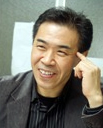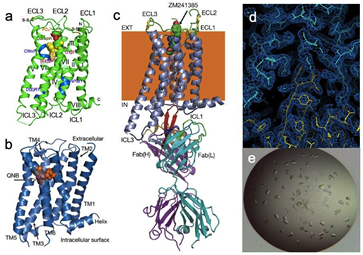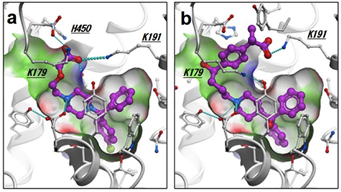
Ph.D. Professor So Iwata
Structural biology can provide a coherent picture of medically relevant phenomena such as regulation of homeostasis and pathogenesis. Our laboratory is focusing to determine structures of membrane proteins associated with human diseases by X-ray crystallography. An increasing emphasis is placed on computational approaches to rational design and screening of novel pharmacologically active compounds as well as molecular dynamics simulation. Our goals include developing a comprehensive understanding of life at the atomic and molecular level and extending this knowledge to elucidate basic principles for modulation of cellular functions with therapeutic benefits.
Research and Education
Membrane proteins, including G protein-coupled receptors (GPCRs), transporters, ion channels and integral membrane enzymes are involved in a large variety of pivotal biological functions and currently the most important class of therapeutic targets. Despite substantial interest in these targets, structure-based drug design (SBDD) has been challenging by a paucity of high-resolution structural information. This reflects the difficulties encountered with the production, the stability, and the crystallization of membrane proteins. To overcome the bottlenecks, our laboratory has developed a state-of-the-art technical platform for membrane protein crystallography and is studying on structures of “druggable” membrane protein targets. The crystal structures will opened up excellent opportunities in structure-based ligand discovery and/or SBDD.
Research is being conducted in cooperation with the Membrane Protein Laboratory (MPL) at British synchrotron radiation facility, Diamond, and Imperial College London, as well as X-ray free electron laser facility, SACLA, in Japan. Our laboratory is ideal for students who aspire to build up an international career.
 1) X-ray crystallography of human G protein-coupled receptors (GPCRs). (a) Histamine H1 receptor (H1R) complexed with doxepin, a first-generation H1R antagonist. (b) M2 muscarinic acetylcholine receptor complexed with QNB, an antagonist. (c) A2a adenosine receptor complexed with an antagonist, ZM241385, and an inverse agonist antibody fragment. (d) An electron density map of a GPCR. (e) Crystals of a GPCR.
1) X-ray crystallography of human G protein-coupled receptors (GPCRs). (a) Histamine H1 receptor (H1R) complexed with doxepin, a first-generation H1R antagonist. (b) M2 muscarinic acetylcholine receptor complexed with QNB, an antagonist. (c) A2a adenosine receptor complexed with an antagonist, ZM241385, and an inverse agonist antibody fragment. (d) An electron density map of a GPCR. (e) Crystals of a GPCR.
 2) In silico docking simulations of second-generation selective H1R antagonists with the H1R ligand-binding pocket. (a) A model of H1R complexed with levocetirizine. (b) A model of H1R complexed with fexofenadine.
2) In silico docking simulations of second-generation selective H1R antagonists with the H1R ligand-binding pocket. (a) A model of H1R complexed with levocetirizine. (b) A model of H1R complexed with fexofenadine.
Recent Publications
-
Asada H, Horita S, Hirata K, Shiroishi M, Shiimura Y, Iwanari H, Hamakubo T, Shimamura T, Nomura N, Kusano-Arai O, Uemura T, Suno C, Kobayashi T and Iwata S. “Crystal structure of the human
angiotensin II type 2 receptor bound to an angiotensin II analog”
Nature Structural & Molecular Biology 25(7): 570-576 (2018) -
Suga, M., Akita, F., Sugahara, M., Kubo, M., Nakajima, Y., Nakane, T., Yamashita, K., Umena, Y., Nakabayashi, M., Yamane, T., Nakano, T., Suzuki, M., Masuda, T., Inoue, S., Kimura, T., Nomura, T., Yonekura, S., Yu, LJ., Sakamoto, T., Motomura, T., Chen, JH., Kato, Y., Noguchi, T., Tono, K., Joti, Y., Kameshima, T., Hatsui, T., Nango, E., Tanaka, R., Naitow, H., Matsuura, Y., Yamashita, A., Yamamoto, M., Nureki, O., Yabashi, M., Ishikawa, T., Iwata, S. and Shen, JR. “Light-induced structural changes and the site of O=O bond formation in PSII caught by XFEL”
Nature. 543:131-135 (2017) -
Nango, E., Royant, A., Kubo, M., Nakane, T., Wickstrand, C., Kimura, T., Tanaka, T., Tono, K., Song, C., Tanaka, R., Arima, T., Yamashita, A., Kobayashi, J., Hosaka, T.,Mizohata, E., Nogly, P., Sugahara, M., Nam, D., Nomura, T., Shimamura, T., Im, D.,Fujiwara, T., Yamanaka, Y., Jeon,Schertler, G., Yabashi, M., Bondar, AN., Standfuss, J., Neutze, R. and Iwata, S. “A three-dimensional movie of structural changes in bacteriorhodopsin.”
Science 354(6319):1552-1557(2016) -
Arakawa, T., Kobayashi-Yurugi, T., Alguel, Y., Iwanari, H., Hatae, H., Iwata, M., Abe, Y., Hino, T., Ikeda-Suno, C., Kuma, H., Kang, D., Murata, T., Hamakubo, T., Cameron, AD., Kobayashi, T.,
Hamasaki, N. and Iwata, S. “Crystal structure of the anion exchanger domain of human erythrocyte band 3.”
Science 350(6261); 680-684 (2015)
-
Nomura, N., Verdon, G,. Kang, HJ., Shimamura, T., Nomura, Y., Sonoda, Y., Hussien, SA., Qureshi, AA., Coincon, M., Sato, Y., Abe, H., Nakada-Nakura, Y., Hino, T., Arakawa, T., Kusano-Arai, O.,
Iwanari, H., Murata, T., Kobayashi, T., Hamakubo, T., Kasahara, M., Iwata, S. and Drew, D. “Structure and mechanism of the mammalian fructose.”
Nature 526; 397-401 (2015)
Laboratory
Professor: So Iwata
Assistant Professor: Norimichi Nomura, Hidetsugu Asada, Tatsuro Shimamura
Assistant Professor: Makoto Adachi, Dohyun Im
TEL:+81-75-753-4372
FAX:+81-75-753-4660
e-mail:s.iwata@mfour.med.kyoto-u.ac.jp
URL:http://cell.mfour.med.kyoto-u.ac.jp/
